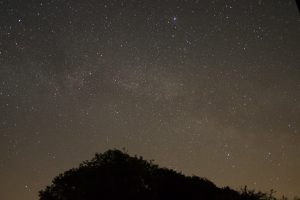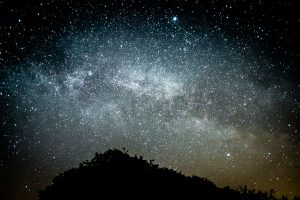Star Gazing
A while back I saw some landscape photographs which were truly remarkable. They had been taken in Southern England at night, but these were not dark pictures and the Milky Way was vividly lit up in the sky, seemingly illuminating the landscape below. I have seen similar images from elsewhere in the world where the stars in our galaxy shine like a celestial ribbon, thinking it a phenomenon made possible where light pollution is less of a problem than it is here. For that reason, I was surprised to see these pictures. The photographer’s strapline was that they showed the countryside as “you have never seen it before”. Certainly the scenes I was seeing were beyond anything I have experienced.
Intrigued, I started wondering how it had been done. Knowing that leaving the camera’s shutter open for a long time amplifies low light levels beyond what the eye can perceive, there was only one way to find out how closely the images matched reality. Try it for myself. By chance I was staying in a part of the country where light pollution levels are low, so I did some research on the Internet on the best approach.
The consensus of the Internet’s hive mind is that a wide-angle lens with as large an aperture as possible works best. Shot wide open at ISO 3200, the exposure time is calculated by divining the focal length into 500, although some advocate that 600 is better. The reason to limit shutter speed is to avoid stars becoming streaks as they move across the sky due to the earth’s rotation. Using the fastest wide-angle I have, a Fuji 18mm f/2 XF lens on a X-Pro1, gave an exposure time of just over 18 seconds when I divided 500 by the full frame equivalent of 27 mm. The 600 option gave an exposure time of around 22 seconds, so I initially tried an exposure of 20 seconds and later 25 seconds.
One issue I encountered was in framing the shot as I could see nothing through either the X-Pro1’s optical or electronic viewfinders. Fortunately, the Milky Way was located in a region of the sky known as the “Summer Triangle” and this proved invaluable. As the name suggests there is bright star at each point which gave me my alignment as I could see them as tiny specks on the rear screen.
The first results were astonishing. Even just looking on the rear LCD screen, I was amazed at just how much is out there. It was a revelation and even if not quite a spiritual experience, it was humbling to think of one’s own fleeting existence as part of something so vast. There was only one problem, in fact. Astounding as they were, my shots looked nothing like the pictures I had seen. Unless someone is flicking a celestial switch to intensify the light from the Milky Way after I have gone to bed, there is something else going on.
A perusal of the photographer’s website whose images prompted my experimentation proved this assumption correct. There was mention of multiple exposures with different settings for the land and sky, albeit with no further details. What I had seen were the results of much post capture processing and blending of images. A friend, who has some knowledge of astrophotography, later confirmed that a lot goes into the production of the final result.
Therein lies part of the problem for me. Photography is regarded as a truthful medium due to the way that it produces pictures by recording light. The camera might not lie, but any shot is inevitably an interpretation of what was seen and not necessarily an accurate record. The last word in the photographer’s tagline that the shots are of the landscape “as you have never seen it before” seems superfluous to me. What is being shown is a construct which does not exist in reality. Spectacular, yes, but maybe a bit overdone for my personal taste. Not that mine is a shared view and the author of the work has achieved considerable success with their pictures. All credit to them for that.
When it came to my own shots, below I show one of my images as it came out of the camera and how it looked after I had pushed and prodded it in Lightroom. Nothing has been added and the adjustments simply brought out what was already there. This shot was made to try out technique and has little aesthetic value, rather it demonstrates the potential of shooting at night. If I find myself in a part of the world which has a suitably dark sky at night and there is a suitable location, it is certainly something I will try. Whether I will wish to bring out the night sky to the same extent as I have here is something to consider if ever I have a suitable shot to work with.


